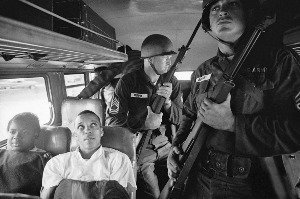
The Freedom Riders movement began May 12, 1961. The Freedom Riders were a group of activists, originally seven black, six white, who protested segregation in the South for seven months. Their goal was to integrate transportation and facilities in the southern states. Their courageous actions during this time sparked massive controversy. They were brutally beaten, arrested, and faced racial oppression. The Freedom Riders are a symbol of justice, civil rights, and activism.
The Freedom Rides were organized by the Congress of Racial Equality also known as CORE. Their journey began in Washington, D.C, to several southern cities, in an effort to use “Whites Only” and “Blacks Only” buses, lunch counters, restrooms, and other facilities. During these trips, they were attacked by white protesters across the South. These attacks then caught the eyes of the media, even internationally.
Their first destination in their Greyhound bus was in Rock Hill, South Carolina where the first act of violence against them took place. Three of the African-American Freedom Riders were attempting to enter a “Whites Only” waiting room. A group of angry whites attacked the activists. Despite the hatred and rage they received, the Freedom Riders continued their planned route. The following day, the activists arrived in Atlanta, Georgia where they switched buses. In Anniston, Alabama on May 14, the second act of violence took place. The Greyhound bus drove into an angry mob of nearly 200 white antagonists. The mob slashed the bus tires, threw blunt objects and tear gas and hit the Freedom Riders with their fists. The Alabama attacks brought attention and spread international controversy. During this controversy in Anniston, the other Freedom Riders who traveled to Birmingham, Alabama on the Trailways bus lines were assaulted by an angry mob.
After the Alabama attacks, the CORE decided to stop supporting the Freedom Riders due to the violence and lack of funding. Diane Nash, an activist from another civil rights group gathered students mostly from Fisk University in Nashville, Tennessee in an effort to continue the Freedom Rides. On May 20, the Freedom Riders resumed their trips under law enforcement escort. As they arrived in Montgomery, Alabama, the police disappeared and another angry white mob assaulted the Freedom Riders with baseball bats and clubs. When the activists stepped off the bus, the police had already left and six hundred
Federal Marshals were called and stopped the riot.
The following night, civil rights activist leader, Martin Luther King Jr. held a ceremony at the First Baptist Church to support the Freedom Riders. Over 1,000 supporters were at the service. A brutal riot began outside the church. Federal Marshals were sent to stop the violence by using teargas. On May 24, the Freedom Riders along with their supporters were arrested in Jackson, Mississippi for breaking county laws regarding separate facilities. They were sentenced to 30 days in jail. By gaining publicity for their heroic protests, the Freedom Riders inspired more activists to join the Civil Rights Movement. A couple of months later, the Interstate Commerce Commission ruled that the bus and train stations were to be integrated.
It has been nearly 57 years since that the influential Civil Rights group referred to as the Freedom Riders fought racial segregation. It was the remarkable year of 1961 that they traveled to help better the segregated areas in the Southern states. John Lewis, a Civil Rights activist, and Freedom Rider became a congressman in 1987. Diane Nash, who held a strong role in the Freedom Riders movement, became a founder of the Student Nonviolent Coordinating Committee. She and more than two dozen of the Freedom Riders went on to become educators, activists, ministers, and politicians. It has been over five decades since the Freedom Riders made an impact on U.S. history.
With much sacrifice, the Freedom Riders set an important tone of power and justice that would last throughout the Civil Rights era. During this time, People of color have faced many challenges, but the Freedom Riders Movement was one of the building blocks of change.
[Source:
NEWSELA, Smithsonian Magazine
]

